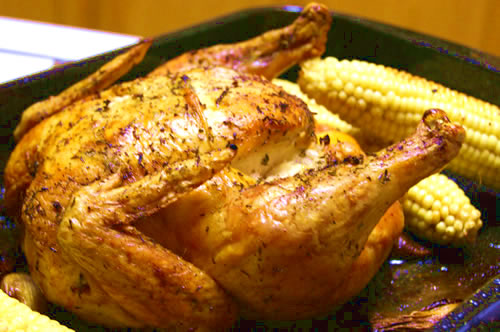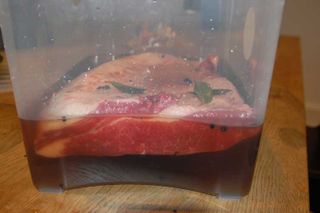 Everyone knows that BBQ goes oh-so-well with beer. Having a kegerator around is sure to bring the two together, and in a major way. But when you are out of beer, and don’t have time to brew, there are a number of options to consider to keep that kegerator working for you. It can be used for canned and bottled beer storage, for sure, but also for brining and curing meats of all sorts.
Everyone knows that BBQ goes oh-so-well with beer. Having a kegerator around is sure to bring the two together, and in a major way. But when you are out of beer, and don’t have time to brew, there are a number of options to consider to keep that kegerator working for you. It can be used for canned and bottled beer storage, for sure, but also for brining and curing meats of all sorts.
Brining meat is, of course, also known as marinating meat. Brine is a form of marinade. The process can infuse exceedingly savory and sweet flavors into your steak, chicken, lamb or whatever meat you prefer. Often, a delicious marinade can make all the difference in the resultant taste of the meat, turning a pale slab of meat into a flavor sensation. Brining usually takes a longer time to come to fruition than marinating, but also ends up with a product that lasts longer in storage.
 Although many marinades are designed to activate flavors with only a few hours of immersion, that time should, for health reasons, be spent in a slightly chilled environment. This will hibernate any potential bacteria that might be present in the meat that cause spoilage. Often, a marinade will also contain alcohol, spices, or vinegar that will be anti-bacterial in one respect or another, as well, but nothing prevents food spoilage as much as keeping the temperature down. Hence, the kegerator is an ideal place to store your brining and marinating meats, especially when your fridge is exceedingly full with the family goods.
Although many marinades are designed to activate flavors with only a few hours of immersion, that time should, for health reasons, be spent in a slightly chilled environment. This will hibernate any potential bacteria that might be present in the meat that cause spoilage. Often, a marinade will also contain alcohol, spices, or vinegar that will be anti-bacterial in one respect or another, as well, but nothing prevents food spoilage as much as keeping the temperature down. Hence, the kegerator is an ideal place to store your brining and marinating meats, especially when your fridge is exceedingly full with the family goods.
Brining meat also moistens cooked meat. Bringing meat hydrates the cells of the muscle tissue before cooking. The process by which the cells are hydrated is osmosis. The surrounding solution of salt and water (brine) causes salt ions to diffuse into the cell, and then absorb water from the surrounding brine as well. This technique is often used in commercial chicken manufacturing to enhance the flavor and the weight of the fowl in question.
Losing moisture in meat is un-avoidable when any type of muscle is cooked. This is why brining is important to cooking and BBQ-ing meats. One problem, which may not be apparent initially, is that the meat may have already been soaked in brine before you even bought it. Always look for any kind of salt or sodium ingredient on your meat. A second brining can make the meat taste way too salty, and actually can be detrimental to the moisture absorbtion of the meat.
When preparing to brine meat in your kegerator, make sure to check the ratio of salt to meat, but also consider the surface area of the meat. Meat with more surface area needs to be brined for a shorter amount of time, because the salt-ion-water-osmosis happens quicker. For example, a 10-pound turkey must be brined for much longer than 10 pounds of shrimp, which have a relatively larger surface area per pound.
Just to give you an idea of what kind of salt ratios and brining times are suitable for brining meats in your kegerator, here is a simple chart of some commonly brined meats:
- Turkey (12-15 pounds) – 2 cups sea salt; 1 gallon water; 14-22 hours depending on size
- Chicken (2-5 pounds) – ½ cup sea salt; 2 quarts water; 3 ½ hours
- Shrimps (1 pound) – 1 cup sea salt; 2 pints water; 40 minutes
- Beef Ribs (3 pounds) – 1 cup sea salt; 1 gallon water; 1 cup sugar; 3 hours
- Smoked Salmon (4 pounds) – ½ cup sea salt; 1 quart water; ¼ cup evaporated can sugar; ¼ cup maple syrup; 2 bay leaves (crumbled); 1 Tablespoon Dill
- Brisket Brine (8-14 pounds)
2 cup warm water
1/4 cup rock or kosher salt
1/3 cup brown sugar
1 onion, diced
2 Tbs. Rosemary, ground
1 Tsp. Bay leaves, ground
1-2 Tbs. of your favorite exotic herb or flavoring (cardamom, caraway, mocha powder)
Also try coriander, powdered lemonade, coffee, chipolte, etc.
Add the following to the brine:
3 cans of beer
3/4 cup vinegar
1/4 cup Worcestershire saucePlace the meat in the brine, turning it once every 8 to 12 hours to insure coverage and penetration.
- Pork Shoulder (6-8 pounds)
1 cup sea salt
1/2 cup brown sugar
1/4 cup molasses
2 tbsp grains of paradise
8 cloves garlic (peeled and minced)
5 bay leaves, torn
3 carrots, peeled and chopped
2 celery stalks, washed and chopped
1 yellow onion, peeled and chopped
5 cups homebrew, dark style preferred
5 cups water
2 quarts ice
Sea salt is always advised for giving the best results in cooking. The industrial nature of other forms of commercial salt production may leave trace chemicals in the salt that can distract from the taste of a finely cooked meal.
Kegerators can also be modified with temperature controllers to chill above or below the suggested temperatures for serving beer. Thusly, you can modify your kegerator to store frozen meat or other foods that require bulk cold storage. Just make sure that you don’t let your beer freeze. If you are looking for more control of the cooling range of your kegerator, you can investigate a great array of temperature controllers from manufacturers such as Johnson Controls and Ranco. Such controllers are available in analog and digital formats, or even as power plug style regulators.
A custom temperature controller can be especially useful if you intend to cure meats in your kegerator, because you can keep the curing meats at an ideal, slightly cool temperature – 40 to 60 degrees Fahrenheit. This will help you to cure the meats without as much trouble from food spoiling bacterium, although certain molds are highly desired to add flavor to specific types of salami and other cured meats.
Keep your keg fridge working for you when the beer runs out and enjoy delicious kegerator brined meats on the grill or in a smoker.



